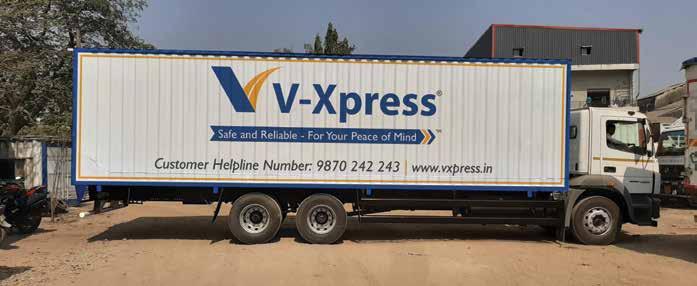
4 minute read
Rajiv Bhatt acharya, COO , V-Xpress
Rajiv Bhatta charya
Dedicated Freight Corridors: A thing to watch out for
Advertisement
This period has taught us many things. We have learned the benefit of staying leaner. I am sure newer technologies and services will emerge across various activities to make functions more efficient and agile. There will also be a huge shift to online and e-commerce platforms which will change the logistics landscape, explains Rajiv
Bhatt achary a, COO, V-Xpress (a division
of V-Tr ans India), in an exclusive conversation with Ajeet Kumar. The sector expert also talks about how to envision and create successful outcomes in a complex environment, which needs significant changes and introduction of efficient policies.
Post-lockdown, how long would you estimate it would take for the industry to get back to business as usual? What will be the growth drivers? As of June, we are almost 70 per cent back to normal. We expect that by July, we should be back to pre-COVID levels provided no further lockdown happens in large pockets and the situation of COVID doesn't go out of control with rising cases.
How has your organisation been providing customer experience during the lockdown? Providing service quality in these times is challenging due to the shortage of labourers and drivers. Most of the longhaul routes are still being operated by a single driver. This adds to longer transit time. Many customers are still non-operational due to which our hubs and delivery branches are getting clogged. Also, the alternate-day open ing in many parts of the country adds to the challenge. However, we have been able to continue to support our customers to ensure the best possible services in these hard times.
The consumer sentiment being low now and considering economic downturn across the globe, what will be the scenario of logistics services required in the next couple of years? There will be a huge shift to online and e-commerce platforms, and this will change the logistics landscape. Due to the liquidity crunch and lower demand, there will be smaller lot sizes and low inventory holding which will enable faster delivery.
More digitisation and contactless documentation will be in high demand. While increased automation in material handling will be used to mitigate issues of labour shortage.
In the later phase of the lockdown, what is the ground reality? Has seamless transport systems been restored? The ground reality remains very challenging. Lesser availability of labour coupled with shortage of drivers is the biggest bottleneck. Clogging of hubs and service centres pose another challenge for sorting; not all our customers are functioning, and we have to choose from the heap and then deliver. Loading and unloading has doubled, leading to poor turnaround time. In some places, we are still not allowed to operate 24x7. Therefore, overall transit times remain a challenge.
The risk of infection amongst the field staff is also high, they have to take extra precautions which add to the time and cost. Besides, the current hike in diesel cost has put us under tremendous pressure. We have been absorbing till

now, but going forward, will have to share the burden with our customers. This will finally affect business cycles. Experts say the industry will also see lot of automation across sectors with fewer staff and more machines doing the job. Is this a curious case of commercial consideration or a business continuity necessity? Certainly, there will be increased automation and use of robotics. This period
has taught us many things. We have learned the benefit of staying leaner. I am sure newer technologies and ser vices will emerge across various activities to make functions more efficient and agile. I think there will be a few areas particularly where the backend processes might see more automation, but on the ground, it will still be hu man-intensive and continue to create employment for the economy. Do you see some modal shifts in the way the industry had been working earlier? Freight trains will be an option which will further evolve as an alternative to trucking. The dedicated freight corri dors will be a thing to be watch for.
However, there is a good amount of scope for both road and rail model to collaborate with each other before they start competing.
Can we expect more automation coming into the entire supply chain for the handling of cargo in a multimodal network? There will be huge scope for automation in this space. Further, with the adoption of material handling and sortation sys tems by more players, the price point will also come down making it more viable and economical.
How can the logistics ecosystem players gear up in supporting India’s dream of becoming a manufacturing hub? Capacity augmentation by the major players will have to be ramped up, which means inclusion of a more skilled work force and development of efficient infrastructure. More warehousing complexes will have to come up and further improve ment in road and rail connectivity should be augmented.
Further, end-to-end digitisation of the entire chain is the need of the hour. Port infrastructure and ease of operation has to be facilitated. Inland waterways will be another game-changer, if devel oped logically.










